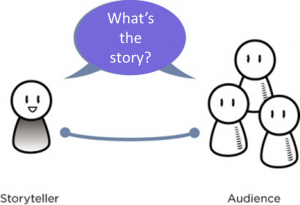Radio has come a long way since gurus Al Ries & Jack Trout literally wrote the book on marketing. Back in the ‘80s, it was must-reading for every PD and promotions director in radio.
Called The 22 Immutable Laws of Marketing, the book took a storytelling approach to positioning and branding. Some of Ries & Trout’s “laws” were controversial, and at times, contradicted each other. Like #8: “In the long run, every market becomes a two horse race,” and #1: “It is better to be first than it is to be better.”
 Radio programmers and research companies regular quoted these guys, and the book became something of a guidebook for how to market radio stations.
Radio programmers and research companies regular quoted these guys, and the book became something of a guidebook for how to market radio stations.
There must be something about the number 22. Because former Pixar writer Emma Coats wrote her “22 Rules of Storytelling.” And if you think about it, Pixar has produced some amazingly great stories during these past two decades, from Toy Story which was released back in 1995 to the breathtaking and poignant Inside Out which premiered earlier this year.
The 22 rules of Pixar-influenced guidance about how to tell a great story is intended for screenwriters, first and foremost. But if you shift your mindset and thinking process a bit, you’ll see wonderful applications of many of Coats’ rules when it comes to the process of preparing a great morning or personality show on the radio.
Her entire list is here thanks to a site called io9. I’ve saved you a little trouble, because while all 22 of her axioms don’t hit the mark, seven of these truisms apply directly to the craft that many radio people should be employing and applying every day they’re on the air.
Here they are:
#2 – You gotta keep in mind what’s interesting to you as an audience, not what’s fun to do as a writer. They can be very different.
And oftentimes that’s very true. What does your audience consider to be humorous, entertaining, informative, and worthy of their time? How can you as a morning show personality, talk show host, news journalist, or producer tap into what you already know interests your target listener? Are you truly in synch with the mindset of your audience? Then go from there.
#7 – Come up with your ending before you figure out your middle. Seriously. Endings are hard, get yours working up front.
This we know to be true. How often do we listen to a bit or feature that has all the potential on the front end, but simply doesn’t pay off? It may have started out with a great premise, but just doesn’t deliver. Even a well-produced bumper into a handful of commercials can’t cover for a segment that just doesn’t have a strong conclusion, punch line, moral, or ultimate purpose. There’s a lot to be said for beginning with the end in mind.
#11 – Putting it on paper lets you start fixing it. If it stays in your head, a perfect idea, you’ll never share it with anyone.
We all know personalities and hosts who fall into this trap. A lot of great meetings and brainstorms that never come to fruition because no one makes the effort to commit it to written form, and fleshing it out individually or with a team. So many great concepts don’t even end up on the cutting room floor because they never became tangible to begin with.
#12 – Discount the first thing that comes to mind. And the second, third, fourth, fifth – get the obvious out of the way. Surprise yourself.
And in the process, surprise your audience. This is perhaps the first rule of brainstorming. Everyone knows that the first idea usually isn’t the best. And oftentimes, the concept that emerges 15 minutes into a bit-writing session is the winner. You hear this a lot in benchmark-driven morning radio but also even in public radio, whether that first inclination – “Let’s open up the phones” or “Let’s do a two-way and have our anchor interview our journalist” – is almost always the least entertaining and interesting choice.
#13 – Give your characters opinions. Passive/malleable might seem likable to you as you write, but it’s poison to the audience.
Characters and people who really don’t have very much interesting to say are forgettable and they’re tune-outs. Personalities with a point of view or an edge need to have presence on any radio show that hopes to captivate and hold an audience. And, of course, the other piece of storytelling kryptonite is whe n co-hosts agree with each other all the time or simply aren’t all that different from one another.
n co-hosts agree with each other all the time or simply aren’t all that different from one another.
#22 – What’s the essence of your story? Most economical telling of it? If you know that, you can build out from there.
It’s interesting that this Pixar-driven rule is in a movie format where there are no meters or occasions to be set. But Emma Coats obviously respects the attention-span as well as the craft of storytelling with as little slop as possible. This doesn’t mean “talk less” as the popular interpretation goes. It does mean looking for ways to tell a story in a clean, concise way that doesn’t waste a listener’s time.
Sometimes, the best rules are the ones written by experts in other fields because they serve as reminders there are universal truths about creating great content.
And that’s true whether we’re talking about animated ogres or two-man morning shows.
And a quote from Ratatouille, “Not everyone can become a great artist, but great artists can come from anywhere.”
Here’s to your greatness.
- Media In 2025: Believe It Or Not! - January 15, 2025
- Every Company Is A Tech Company - January 14, 2025
- The Changing Face Of Social Media (OR WTZ?!) - January 13, 2025




Thank You!